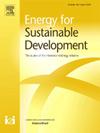Towards urban-rural development and equity in Western China: Insights gained from residential buildings' carbon emissions and per capita income
IF 4.4
2区 工程技术
Q2 ENERGY & FUELS
引用次数: 0
Abstract
The development and equity of urban and rural are crucial for the well-being of residents. However, the specific patterns of urban-rural integration (URI) and their impacts on regional energy development and equity, particularly in Western China, remain unclear. This paper proposes a new framework that combines the decoupling approach with the Gini coefficient, aiming to analyze the relationship between residential building carbon emissions and per capita income under different URI patterns from 2016 to 2020. The findings indicate that: (1) The western region can be divided into comprehensive development (CD), comprehensive lagging (CL), rural revitalization leading (RRL) and new urbanization leading (NUL) cities. Among them, the proportion of CL cities is 21.3 % (the smallest among all patterns), primarily distributed in the provinces of Qinghai and Guangxi. (2) Overall, rural areas exhibit better decoupling performance than urban areas. However, urban decoupling has gradually improved over time, with cities experiencing strong or weak decoupling reaching 52.8 %. (3) For cities like CD cities, there are significant urban-rural inequalities in per capita income, but smaller differences in residential buildings' carbon emissions. It is worth noting that NUL cities perform well both in terms of carbon emissions and income equity. The overall assessment of this study can be used as an input to the formulation of carbon reduction targets and subsidy policies to help achieve a more equitable energy transition.
中国西部城乡发展与公平:基于住宅建筑碳排放和人均收入的启示
城乡的发展和公平对居民的福祉至关重要。然而,城乡一体化的具体模式及其对区域能源发展和公平的影响,特别是在中国西部地区,尚不清楚。本文提出了一个将解耦方法与基尼系数相结合的新框架,旨在分析2016 - 2020年不同URI模式下住宅建筑碳排放与人均收入的关系。研究结果表明:①西部地区可划分为综合发展型城市、综合滞后型城市、乡村振兴主导型城市和新型城镇化主导型城市;其中CL型城市占比21.3%(最小),主要分布在青海和广西两省。(2)总体而言,农村地区的脱钩表现优于城市地区。然而,随着时间的推移,城市脱钩逐渐改善,出现强弱脱钩的城市比例达到52.8%。(3) CD等城市的人均收入存在显著的城乡差距,但住宅建筑碳排放差异较小。值得注意的是,NUL城市在碳排放和收入公平方面都表现良好。本研究的总体评估可以作为碳减排目标和补贴政策制定的投入,以帮助实现更公平的能源转型。
本文章由计算机程序翻译,如有差异,请以英文原文为准。
求助全文
约1分钟内获得全文
求助全文
来源期刊

Energy for Sustainable Development
ENERGY & FUELS-ENERGY & FUELS
CiteScore
8.10
自引率
9.10%
发文量
187
审稿时长
6-12 weeks
期刊介绍:
Published on behalf of the International Energy Initiative, Energy for Sustainable Development is the journal for decision makers, managers, consultants, policy makers, planners and researchers in both government and non-government organizations. It publishes original research and reviews about energy in developing countries, sustainable development, energy resources, technologies, policies and interactions.
 求助内容:
求助内容: 应助结果提醒方式:
应助结果提醒方式:


